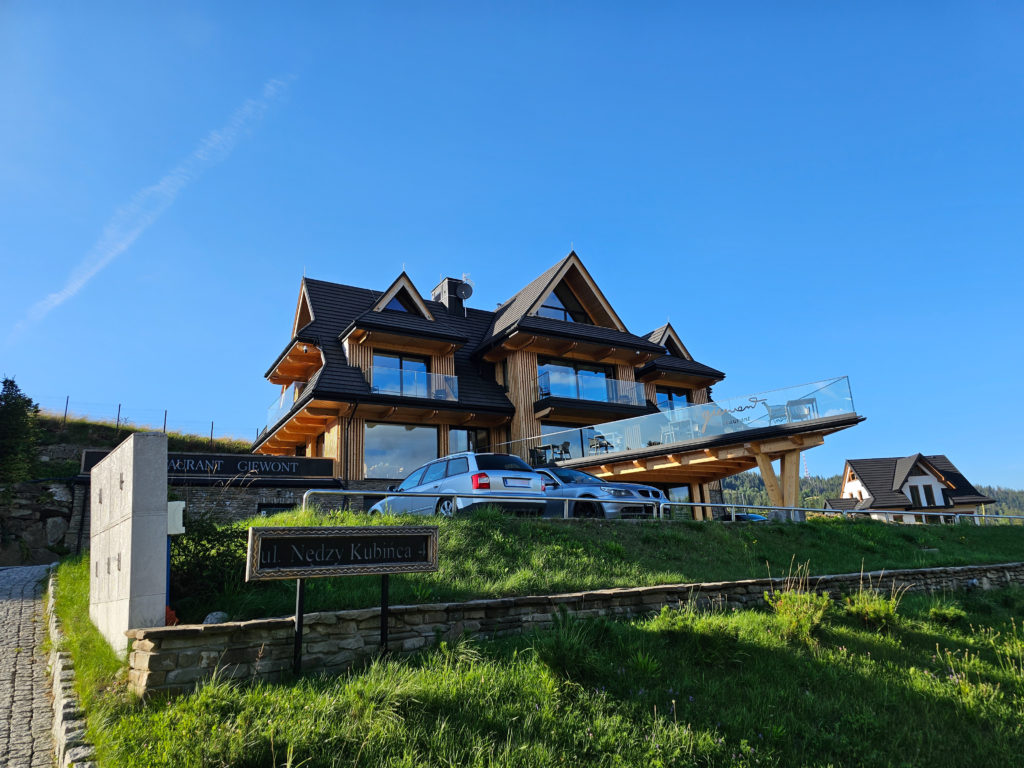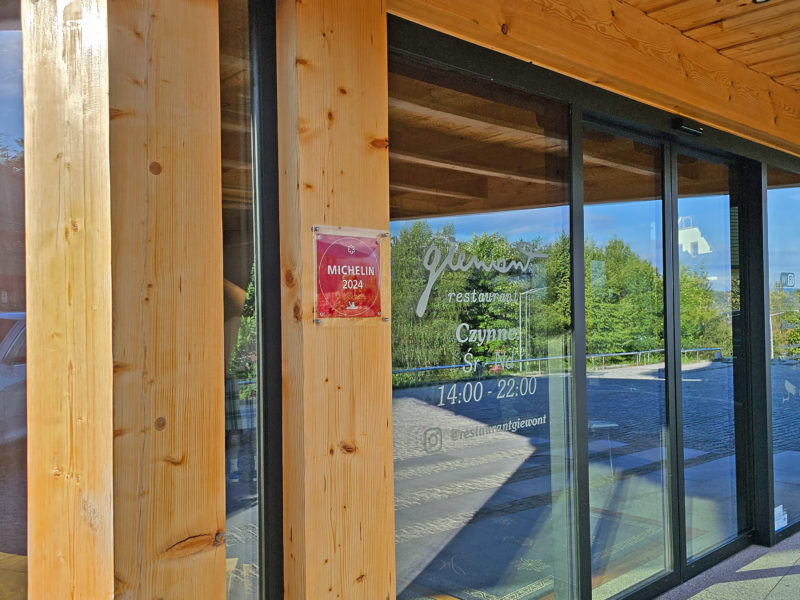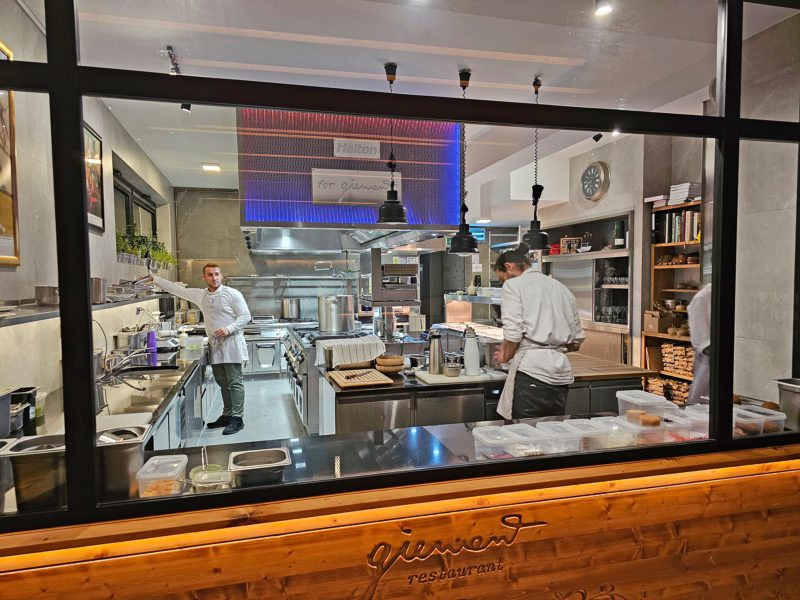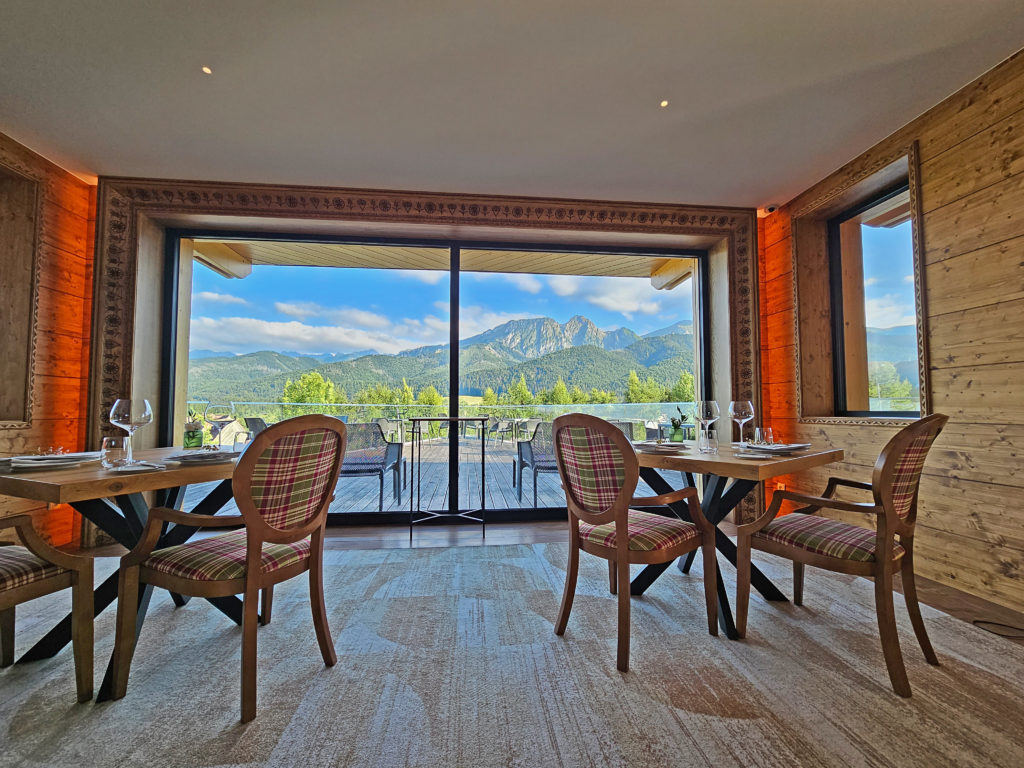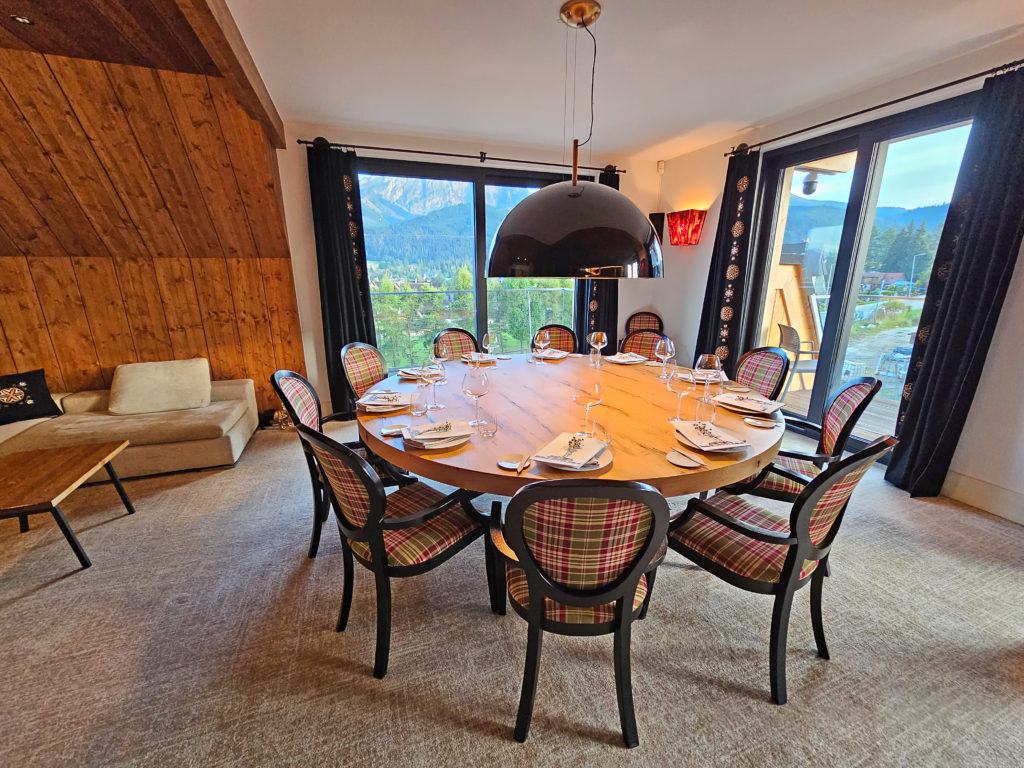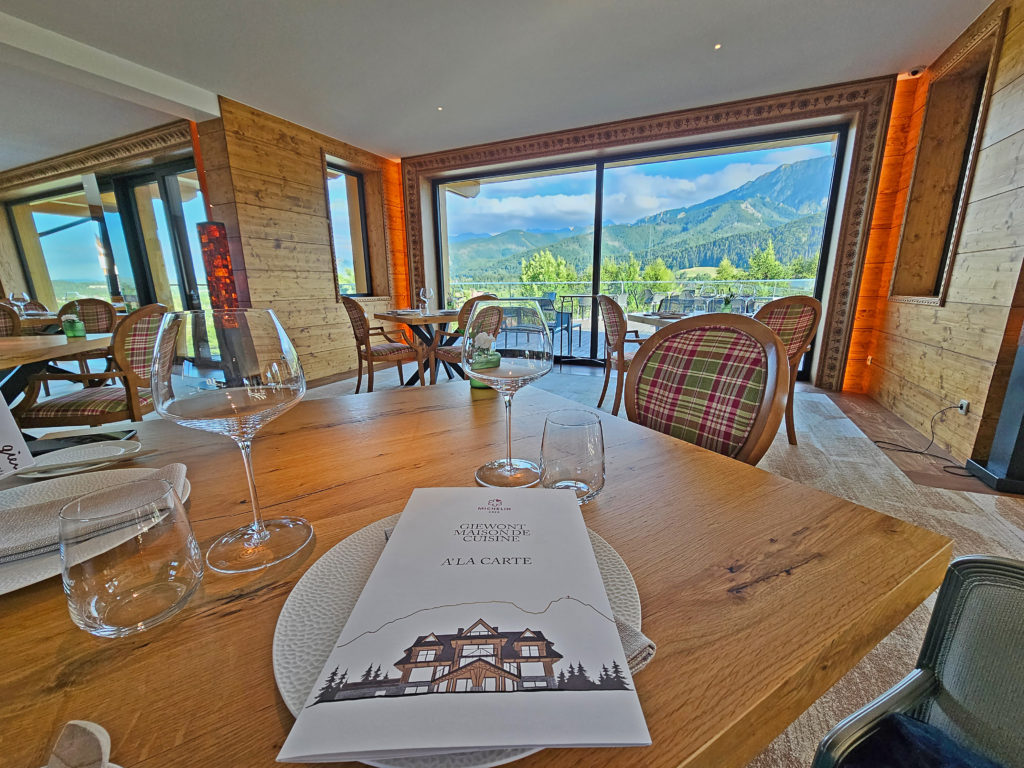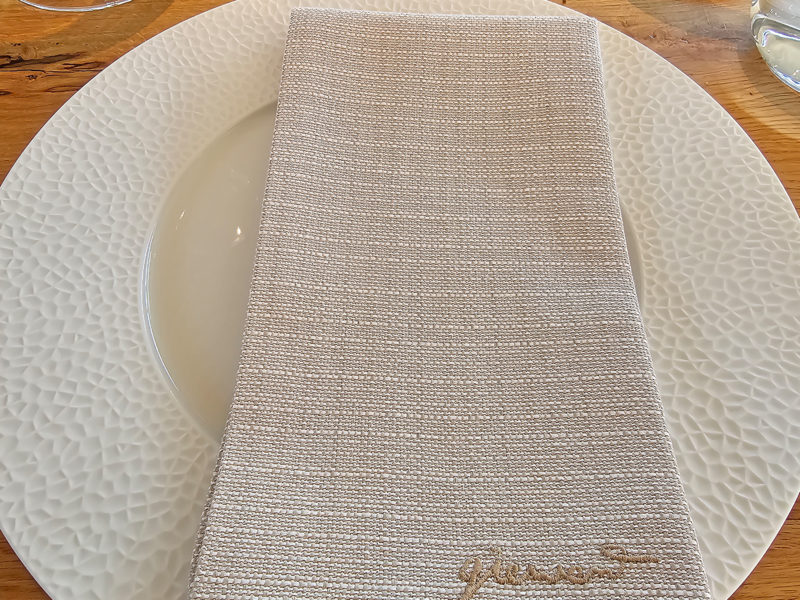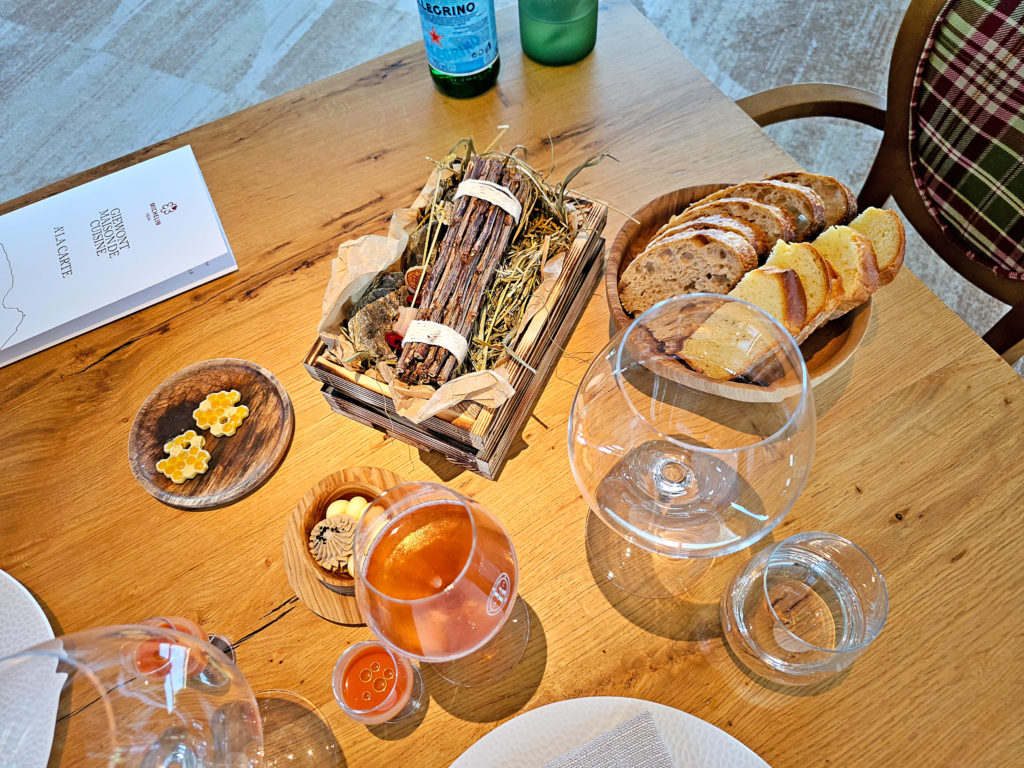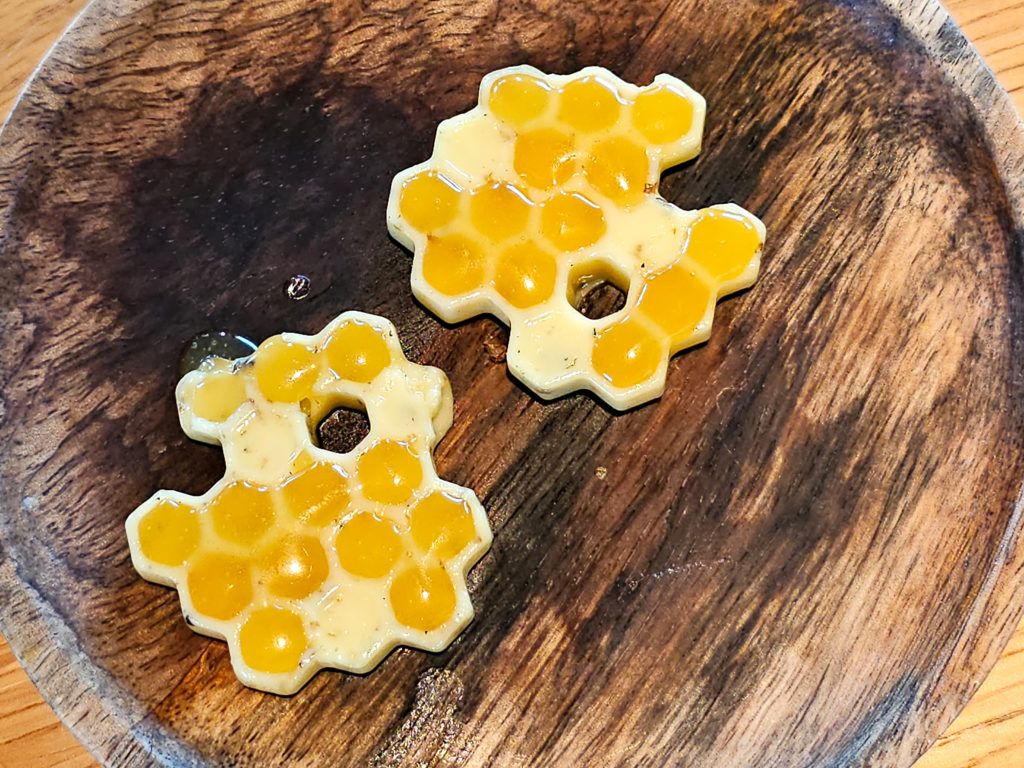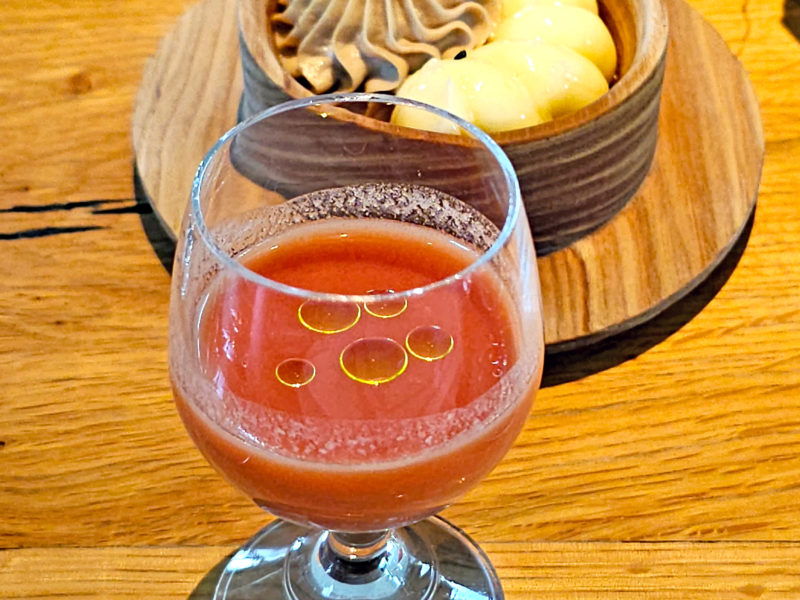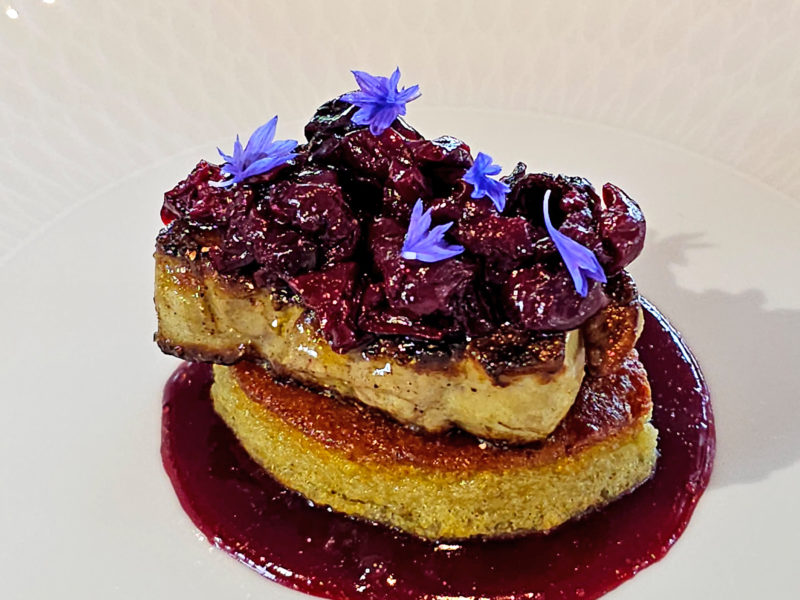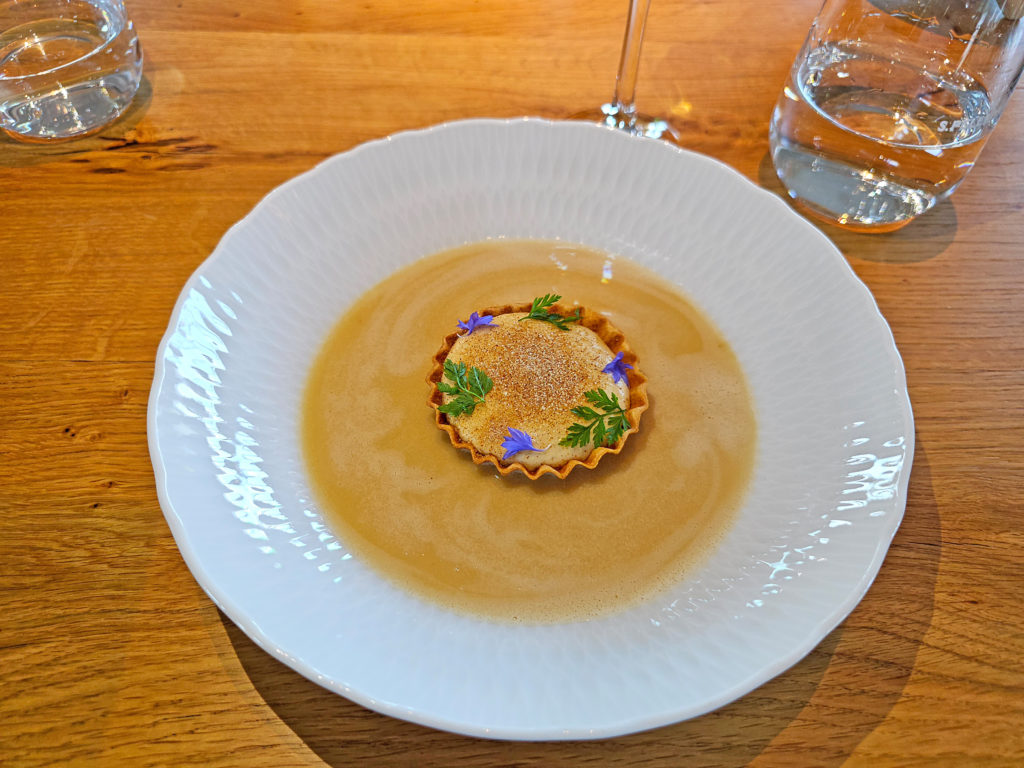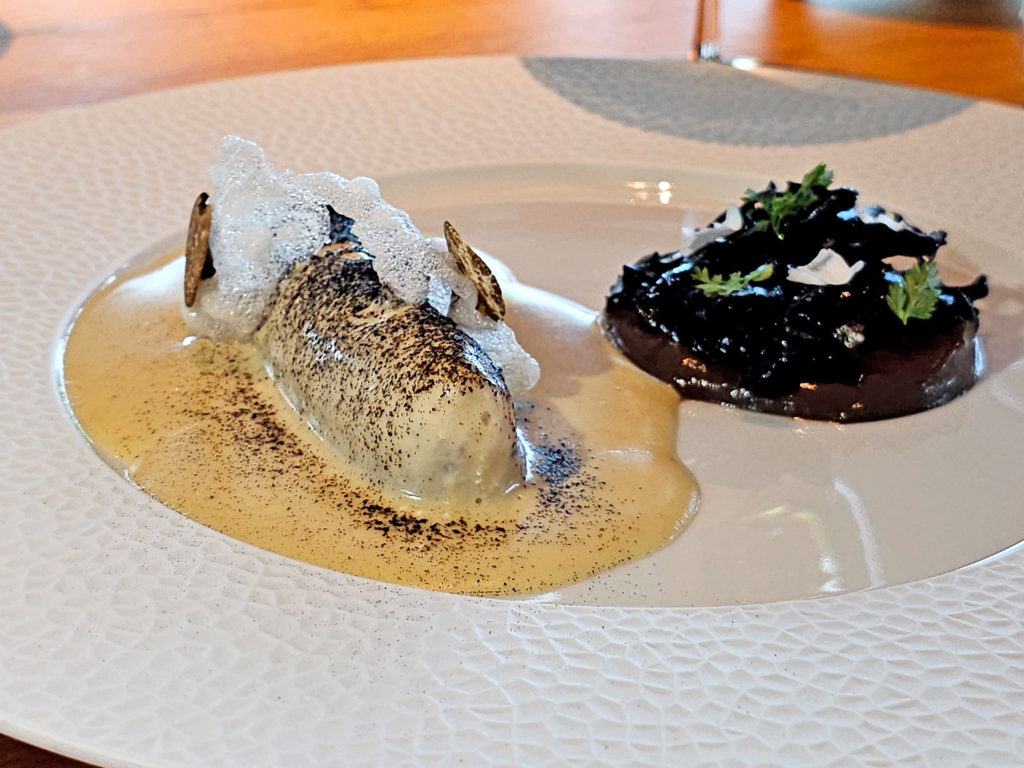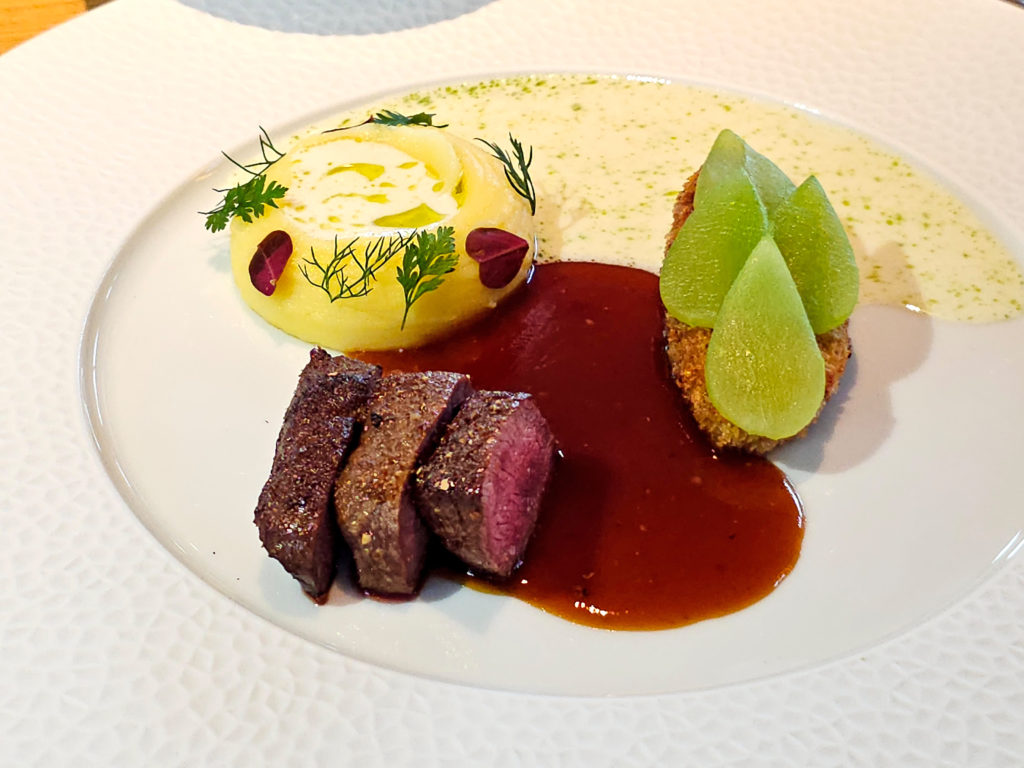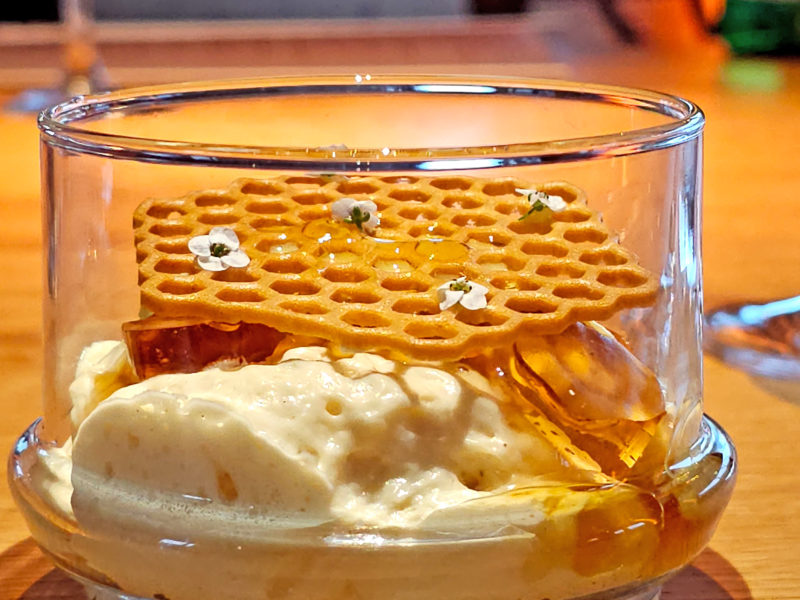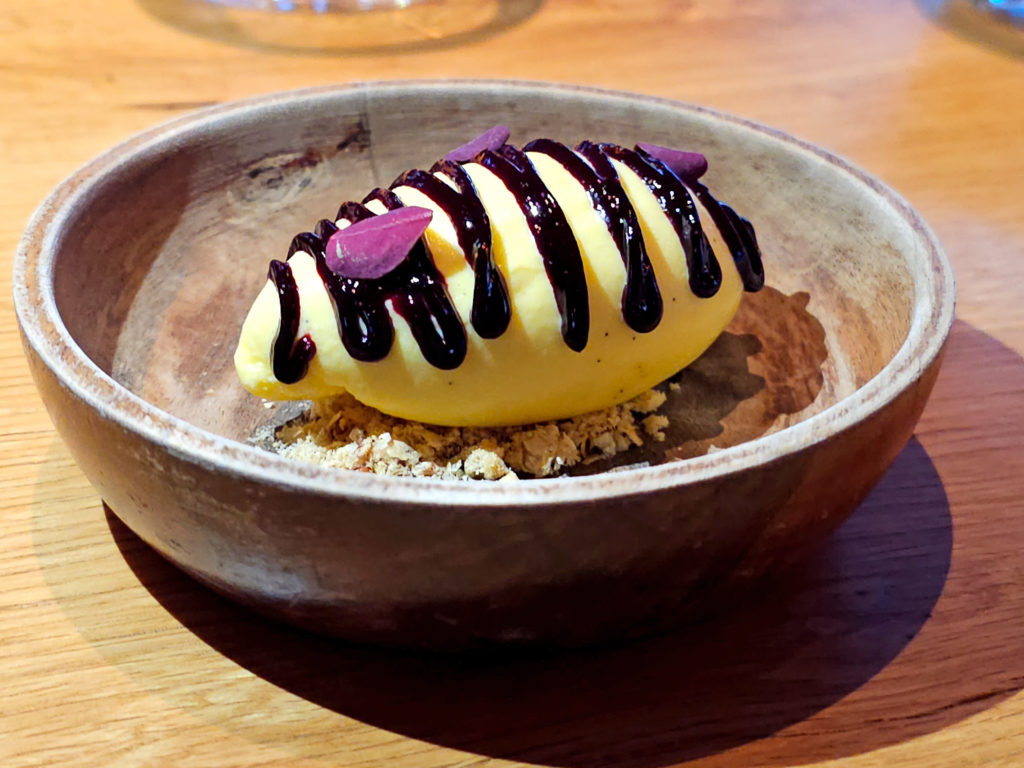When the restaurant Giewont received its Michelin star, we decided we absolutely had to visit. It is the only Michelin-starred restaurant in Poland located outside of a major city, which made us all the more eager to discover what had captivated the Michelin inspectors. Kościelisko is very far from where we live, but we finally managed to make it to the Podhale region. We were very curious to experience a Michelin-star interpretation of Podhale cuisine—and we must admit, we were not disappointed.
The restaurant is housed in a standalone building which, as we learned, was originally intended to be a residential home, but ultimately became a restaurant. The name of the restaurant is no coincidence, as its windows offer a perfect view of Poland’s most famous peak—Giewont. Since the windows are large, the views are absolutely stunning.
Upon entering the building, you can see the glass-walled kitchen. The main dining room is located on the first floor. There is also a spacious terrace there, offering a breathtaking view of the Tatra Mountains. On the next floor, there is a VIP room where more intimate gatherings can be held—even children under the age of 10 are allowed to participate in such events.
The dining room’s décor is inspired by restaurants in the French Alps. Wooden tables and chairs, a neutral carpet, and wooden walls provide a brilliant backdrop for the panoramic windows. Chef Przemysław Sieradzki made a very positive impression on us. From a brief conversation, we learned that he travels extensively, seeks inspiration, and is familiar with top Michelin-starred restaurants. We appreciate that in his cooking he strives to use local ingredients, traditions, and recipes, which he presents in a fresh and creative way. A big plus for us is also that many of the ingredients are sourced from local suppliers, as we could read on one of the pages of the menu.
At the restaurant, guests can choose from a classic tasting menu strongly inspired by Podhale cuisine, a seasonal tasting menu, a vegan tasting menu, or a set of three or four à la carte dishes. It’s an interesting option for those who are just beginning their fine dining journey. A wine pairing can also be selected with the tasting menus. Wanting to experience the chef’s talent, we chose the classic tasting menu.
The tasting began with small amuse-bouches. These included a small glass of gazpacho and a croquette made from lamb leg with seared lard and carrot marinated in beet juice. Alongside, two types of bread were served—brioche and sourdough made from a ten-year-old starter—as well as chestnut pâté and Maldon salt butter. Another addition that pleasantly surprised us was the honey and black truffle butter. We were charmed by the fact that the honey was served with the butter as a nod to the Podhale Christmas Eve tradition, in which one dips the wafer in honey for good fortune.
As for this first chapter of the meal, we were left slightly wanting. The gazpacho was quite delicate, and the croquettes were so tiny they were barely noticeable among the twigs on the wooden tray. These first snacks usually make a big impression during tasting dinners. Here, there was a slight sense of insufficiency, even though everything was very tasty.
The first appetizer was tartare and carpaccio made from beef supplied by a local provider, both wet- and dry-aged. The tartare was served with shallot, black trumpet mushroom, and rye bread chips. It must be said that this was a very successful composition, with the distinct flavor of the meat clearly coming through and the aroma of the shallot being delicate and not overpowering.
The next dish stole our hearts. It was brilliantly caramelized duck foie gras, served on moskol—a traditional local flatbread made from potatoes and wheat flour, baked in an oven. It was accompanied by cherries with lavender and a cherry sauce inspired by the cherry orchard of the chef’s parents. The foie gras, moskol, and cherries complemented each other perfectly and also paired wonderfully with the Gewürztraminer. Pure poetry.
The next dish was kwaśnica—or rather, a signature interpretation of it, which, truth be told, we had been eagerly anticipating. At Giewont, kwaśnica is not served in the traditional Podhale form but as a creamy soup thickened with butter, with a puff pastry tartlet placed in the center of the plate, filled with lamb leg and topped with potato foam and powder.
The dish was quite delicate in flavor, so if one expects the strong, sour punch of a traditional kwaśnica, there might be a slight sense of disappointment. However, we found this version very appealing. Despite its subtle taste and gentle texture, it combined the characteristic aromas of kwaśnica in a more refined form.
We weren’t fans of the pairing for this dish—this time a strong horseradish vodka was served, which we felt overpowered the flavor of the dish. That said, we have to admit that it was certainly an interesting and bold combination.
The first main course was trout raised at an altitude of over 1,000 meters above sea level, topped with truffle purée and a cow cheese sauce, along with black trumpet mushroom powder. Beside the fish on the plate was a purée of black trumpet mushrooms with wild garlic, accompanied by both fried and pickled black trumpet mushrooms. We appreciated the fish’s perfect texture, the very interesting combination of flavors, and the creativity in using the black trumpet mushroom in multiple forms.
After this dish, it was time for an intermezzo: a cold infusion of fireweed with mint, freeze-dried strawberry, white and red currants, and haskap berry. The infusion was served cold, making it wonderfully refreshing. Fruity and minty notes were clearly perceptible in the flavor.
The next and final main course was meant to evoke memories of a Sunday dinner. On the plate was a piece of lamb, accompanied by a meatball with compressed cucumber and a sauce reminiscent of mizeria—slightly sweet, just as the chef’s grandmother used to prepare it. Alongside was a purée of potatoes and onions, served with mint oil. It was an aromatic dish that truly did bring to mind homemade Sunday lunches, though in a very modern interpretation despite its classic form.
We were charmed by the dessert called “everything from the bee.” In a glass bowl, sheep’s milk yogurt was served with bee bread foam (made from fermented pollen), propolis ice cream (made from bee resin), mead in the form of a jelly, and an egg yolk foam chip—all topped with oak honeydew honey. Thanks to the yogurt, the dessert was not overly sweet, and all the elements blended together perfectly. We were truly enchanted by this dessert.
As petit fours, we were served vanilla ice cream with freeze-dried white currants and a blackcurrant sauce enriched with 12-year-old balsamic vinegar.
We had no complaints about the service—it was both very pleasant and professional. We enjoyed our conversations, and we learned a lot about the cuisine, the restaurant itself, and the ingredients used to prepare the dishes.
If we were to point out any shortcomings, it would be just two elements. We weren’t entirely convinced by the fact that all wines were served in the same type of glass. Perhaps there is a concept behind this choice, but it bothered us, as the wines were quite different from one another. It might seem like a small detail, but the glass in which wine is served really does make a difference. Unfortunately, the selection of teas was also very limited. Instead of green tea, we were offered mint, which was served in a stainless steel teapot with visible dishwasher streaks.
Despite these minor shortcomings, we consider our visit a great success. The traditional menu at Giewont presents a modern take on the culinary traditions of the region and offers a very interesting perspective on local cuisine. We have to say, we really appreciated this connection to tradition. The dishes are generally fairly conservative and classic in form (by this, we mean traditional pairings like foie gras with fruit, or meat with potatoes as a main course), but they are prepared with finesse and, most importantly, they are delicious. We would gladly return to try the seasonal menu and see what else the chef might surprise us with.

